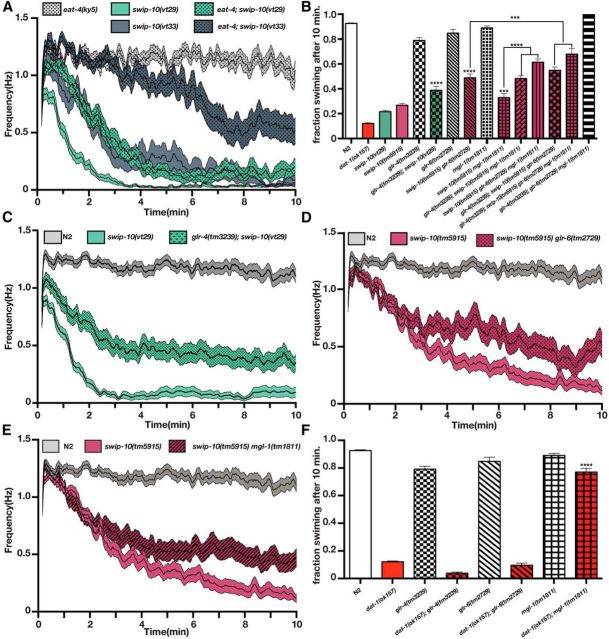Figure 6.
swip-10 paralysis is dependent on vesicular Glu release and GluRs. A, Automated thrashing analysis reveals that swip-10 paralysis suppressed by loss of the vesicular GLT eat-4. Curves represent the average thrashing frequency of at least 25 independent animals recorded over the course of several sessions. eat-4;swip-10(vt29) is significantly suppressed from swip-10(vt29) progeny during minutes 1–3 and eat-4;swip-10(vt33) is significantly suppressed from swip-10(vt33) from minutes 2–10. We did not observe any significant difference between eat-4 and N2 (data not shown). B, Loss of glr-4, glr-6, and mgl-1 additively suppress swip-10 paralysis. Individual mutations of these GluRs have no impact on swimming behavior. C, Loss of glr-4 significantly suppresses swip-10(vt29). glr-4;swip-10 is significantly elevated from swip-10(vt29) starting in the first minute. D, Loss of glr-6 significantly suppresses swip-10(tm5915) in minutes 4–10. E, Loss of mgl-1 significantly suppresses swip-10(tm5915) in minutes 3–10. F, Loss of mgl-1 significantly restores dat-1 Swip, whereas loss of glr-4 or glr-6 does not affect dat-1 paralysis. For all panels, double and triple mutant strains were constructed and assays were performed as described in the Materials and Methods. For B and F, data were analyzed by one-way ANOVA with multiple Bonferroni posttests. ***p < 0.001, ****p < 0.0001. For A, B, D, and E, single worm recordings were performed as described in the Materials and Methods and analyzed with SwimR. Data were analyzed by two-way ANOVA with multiple Bonferroni posttests at each time point.

